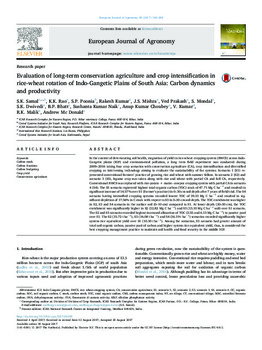Mostrar el registro sencillo del ítem
Evaluation of long-term conservation agriculture and crop intensification in rice-wheat rotation of Indo-Gangetic Plains of South Asia: carbon dynamics and productivity
| Autor: | Samal, S.K. |
| Autor: | Rao, K.K. |
| Autor: | Poonia, S.P. |
| Autor: | Kumar, R. |
| Autor: | Mishra, J.S. |
| Autor: | Prakash, V. |
| Autor: | Mondal, S. |
| Autor: | Dwivedi, S.K. |
| Autor: | Bhatt, B.P. |
| Autor: | Naik, S.K. |
| Autor: | Choubey, A.K. |
| Autor: | Kumar, V. |
| Autor: | Malik, R. |
| Autor: | McDonald, A. |
| Año: | 2017 |
| URI: | https://hdl.handle.net/10883/19277 |
| Resumen: | In the context of deteriorating soil health, stagnation of yield in rice-wheat cropping system (RWCS) across Indo- Gangetic plains (IGP) and environmental pollution, a long term field experiment was conducted during 2009–2016 taking four crop scenarios with conservation agriculture (CA), crop intensification and diversified cropping as intervening technology aiming to evaluate the sustainability of the systems. Scenario 1 (S1) represented conventional farmers’ practice of growing rice and wheat with summer fallow. In scenario 2 (S2) and scenario 3 (S3), legume crop was taken along with rice and wheat with partial CA and full CA, respectively. Conventional RWCS was replaced with rice-potato + maize- cowpea cropping system with partial CA in scenario 4 (S4). The S3 scenario registered highest total organic carbon (TOC) stock of 47.71 Mg C ha−1 and resulted in significant increase of 14.57% over S1 (Farmer’s practice) in 0–30 cm soil depth after 7 years of field trial. The S4 scenario having intensified cropping systems recorded lowest TOC of 39.33 Mg C ha−1 and resulted in significant depletion of 17.56% in C stock with respect to S3 in 0–30 cm soil depth. The TOC enrichment was higher in S2, S3 and S4 scenario in the surface soil (0–10 cm) compared to S1. At lower depth (20–30 cm), the TOC enrichment was significantly higher in S2 (12.82 Mg C ha−1) and S3 (13.10 Mg C ha−1 soil) over S1 scenario. The S2 and S3 scenario recorded highest increased allocation of TOC (3.55 and 6.13 Mg C ha−1) to passive pool over S1. The S2 (15.72 t ha−1), S3 (16.08 t ha−1) and S4 (16.39 t ha−1) scenarios recorded significantly higher system rice equivalent yield over S1 (10.30 t ha−1). Among the scenarios, S3 scenario had greater amount of total soil organic carbon, passive pool of carbon and higher system rice equivalent yield, thus, is considered the best cropping management practice to maintain soil health and food security in the middle IGP. |
| Formato: | |
| Lenguaje: | English |
| Editor: | Elsevier |
| Copyright: | CIMMYT manages Intellectual Assets as International Public Goods. The user is free to download, print, store and share this work. In case you want to translate or create any other derivative work and share or distribute such translation/derivative work, please contact CIMMYT-Knowledge-Center@cgiar.org indicating the work you want to use and the kind of use you intend; CIMMYT will contact you with the suitable license for that purpose. |
| Tipo: | Article |
| Lugar de publicación: | Amsterdam, Netherlands |
| Páginas: | 198-208 |
| Volumen: | 90 |
| DOI: | 10.1016/j.eja.2017.08.006 |
| Palabras Claves: | Carbon Stock |
| Palabras Claves: | Carbon Fractions |
| Palabras Claves: | Carbon Budgeting |
| CRP: | Wheat |
| Agrovoc: | CARBON |
| Agrovoc: | CROP YIELD |
| Agrovoc: | CONSERVATION AGRICULTURE |
| Agrovoc: | WHEAT |
| Agrovoc: | RICE |
| Revista: | European Journal of Agronomy |
Ficheros en el ítem
Este ítem aparece en la(s) siguiente(s) colección(ones)
-
Sustainable Intensification
Sustainable intensification agriculture including topics on cropping systems, agronomy, soil, mechanization, precision agriculture, etc.

